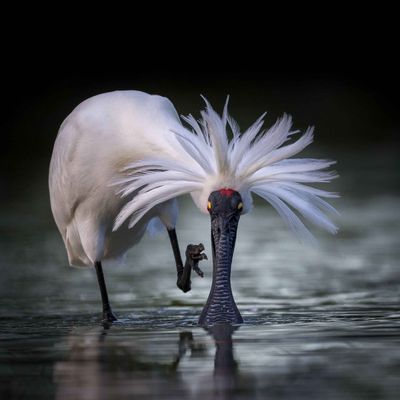There’s something timeless about a perfectly mirrored reflection of a bird on still water. Whether it’s a graceful Wrybill poised at dawn or a duck gliding through glassy shallows, reflection shots add symmetry, depth, and a sense of tranquility to your bird photography. But nailing these images takes more than luck, it requires patience, technique, and a bit of nature’s cooperation. Here are the key elements to capturing successful bird reflection shots:
Light is Everything
Soft, even lighting, typically found during golden hour is favourable. Low-angle light at sunrise or sunset not only enhances the bird’s form and plumage but also adds warmth and texture to the water, like in this image below. Harsh midday light creates distracting highlights and kills the reflection. Overcast days can also work well, offering even tones and subtle contrasts. This photo was taken on a recent trip to Napier in the early soft morning light.
Stillness of Water
Reflections thrive on calm surfaces. Windless mornings or protected wetlands, or estuaries offer the best chances for mirror-like conditions. Even the tiniest ripple can distort a reflection, so positioning yourself near sheltered inlets or lagoons can greatly improve your results. The image below shows how the slightest wind can effect the image.
Angle and Perspective
Getting low is key. A lower angle aligns your lens with the surface of the water, exaggerating the reflection and creating that powerful symmetry. Lying flat, using a right-angle viewfinder, or shooting from a floating hide can all help achieve that ideal perspective.
Composition Matters
Look for balance. Reflections are naturally symmetrical, so consider vertical orientation to emphasize that symmetry. Don’t always centre the bird, off-centre compositions with strong leading lines or natural framing can add depth and storytelling.
Anticipate the Moment
Birds are unpredictable, but observation pays off. Spend time watching their routines and body language. A quiet pause, a subtle tilt of the head, or a raised wing just before takeoff can turn a simple shot into a captivating image. Patience is your most valuable tool. Use a long lens (300mm or more) to avoid disturbing the bird. Keep your shutter speed high (above 1/1000th sec) to freeze subtle motion, and shoot wide open to help blur the background. Focus on the eye, as it’s the anchor for both the bird and its reflection.
Reflections, like all great bird photography moments, reward those who slow down, observe, and let nature lead. With calm water, gentle light, and patience, you’ll capture images that feel both intimate and infinite.
In November 2025 I will be holding three workshops in the Hawkes Bay where we spend a couple mornings mastering these beautiful shots. All information can be found below.






